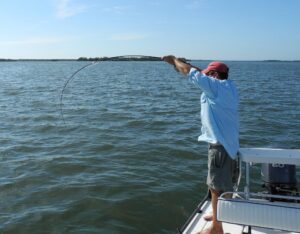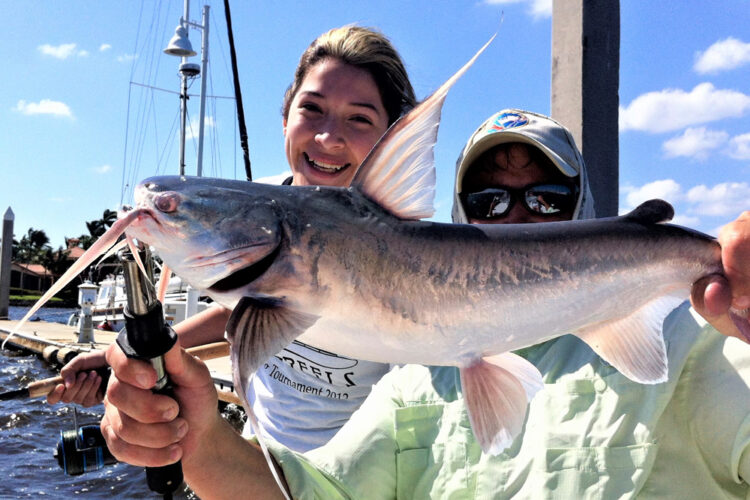One Angler’s Trash Fish Just Might Be Another’s Treasure
by Debbie Hanson
Once a member of the “trash can slam,” the feisty sail cat is enjoying a new level of respect.
If gafftopsail catfish could talk, they’d likely borrow late comedian Rodney Dangerfield’s catchphrase, “I don’t get no respect!” Historically, saltwater cats have rarely been targeted by sport anglers. They certainly haven’t been anywhere near as popular as their freshwater counterparts. In fact, most anglers label them as a nuisance species, undesirable bycatch, and the most despised member of the infamous “trash can slam” club.
Could this mindset be starting to shift though? Based on the recent flurry of social media posts and YouTube videos, the gafftopsail seems to be generating a fair amount of esteem among fly and lure anglers. As it turns out, gafftops aren’t just the passive bottom feeders many mistakenly believe them to be. The fact is, they are very willing to take an actively worked streamer fly or jig. That’s right, you can leave the cut baits, chicken livers, and stink bait behind.
The Where and Why of Gafftopsail Cats
Aptly named for the pronounced dorsal fin that rises from their back like a sail, gafftopsail catfish are common in Florida’s saltwater back bays and estuaries, particularly on the gulf side of the state. They can be found near beaches, canals, mangroves, under docks, and around river mouths in brackish waters.
Those who have an affinity for catching freshwater catfish will find that the saltwater gafftopsail cat provides a similarly dogged fight. While gafftopsails don’t reach the hefty sizes and weights that freshwater blue cats do, they can grow up to 24 inches and tip the scales near ten pounds. In fact, gafftops are known for growing faster and larger than their saltwater cousins, the hardhead catfish.
Saltwater Gafftopsail Cats on Fly and Jigs
Kayak fly fishing guide Drei Stroman is one angler who feels that gafftopsail catfish deserve more respect than they have historically received.

“I grew up fishing for blue and channel catfish in the Midwest with my dad,” recalled Stroman. “Here in Southwest Florida, I like targeting sail cats because they very actively chase down flies. The key is to strip your fly fast near the bottom. I say near the bottom because you want to be close to the bottom, but not actually on the bottom.”
Stroman uses a 6 or 7 weight fly set-up with intermediate line, tapered fluorocarbon leader, and brings along plenty of baitfish imitating flies.
“I’ve had my best success catching gafftopsails using either a white baitfish pattern or a pinfish pattern,” he said. “Granted, once you catch a gafftopsail, your fly is done. Be prepared to sacrifice a lot of flies, just like you do if you fly fish for mackerel. It’s just part of it.”.
In addition to baitfish-imitating flies, gafftopsail cats have a penchant for bucktail jigs. Captain Jim Fortman ties his own custom bucktail jigs and says that the bigger sail cats down in the 10,000 Islands frequently hit his ¼-ounce and ½-ounce jigs.
“They really seem to key in on brown bucktail jigs,” he noted. “This is especially true during the late spring and summer when they are spawning over inshore mudflats.”
Handle With Care

Once you know what to use to entice a gafftop, it’s important to know how to carefully remove your hook or flies without getting spined. Just like other catfish species, gafftops have sharp spines that support the dorsal fin on the top of the fish and the pectoral fins on the fish’s sides. These spines aren’t just sharp, they’re also serrated and coated with thick slime that includes a mild toxin. I know, I know… this all sounds a bit precarious, but when handled correctly and carefully, a sail cat’s defenses shouldn’t deter you from a fight that Stroman equates to that of a redfish.
Stroman isn’t alone when it comes to his appreciation for gafftopsails. Casting instructor Joe Mahler also feels that sail cats haven’t received their due credit. He grew up fishing for channel cats and bullheads in Indiana, so targeting and handling gafftopsail cats in Southwest Florida’s inshore gulf waters brings on feelings of nostalgia for him.
“Fishing for freshwater catfish was one of my favorite things to do as a kid while growing up in Indiana,” he commented. “As a result, I became very comfortable with handling catfish.”
“The most secure way to handle a sail cat, in my opinion, is to carefully put the palm of your hand on the bottom side of the catfish, advised Mahler. “Put your thumb firmly underneath one pectoral fin, then put the other pectoral fin between your middle finger and ring finger.”
He says that the larger sail cats are much easier to hold because they flop around a lot less than saltwater hardhead catfish and small sail cats. You can also use a lip-gripping device, like a Boga Grip or plastic floating fish gripper, which clamps down firmly on the fish’s bottom lip – again, just be sure to keep your hands away from the spines.
Chase a Few Salty Whiskers
While gafftopsail catfish may not be the species you initially had in mind to pursue on your next saltwater trip, what angler doesn’t love the idea of busting a fishing myth or two? Get out a few flies or bucktail jigs to see for yourself if the fight of a sassy saltwater sail cat lives up to all the latest buzz.



